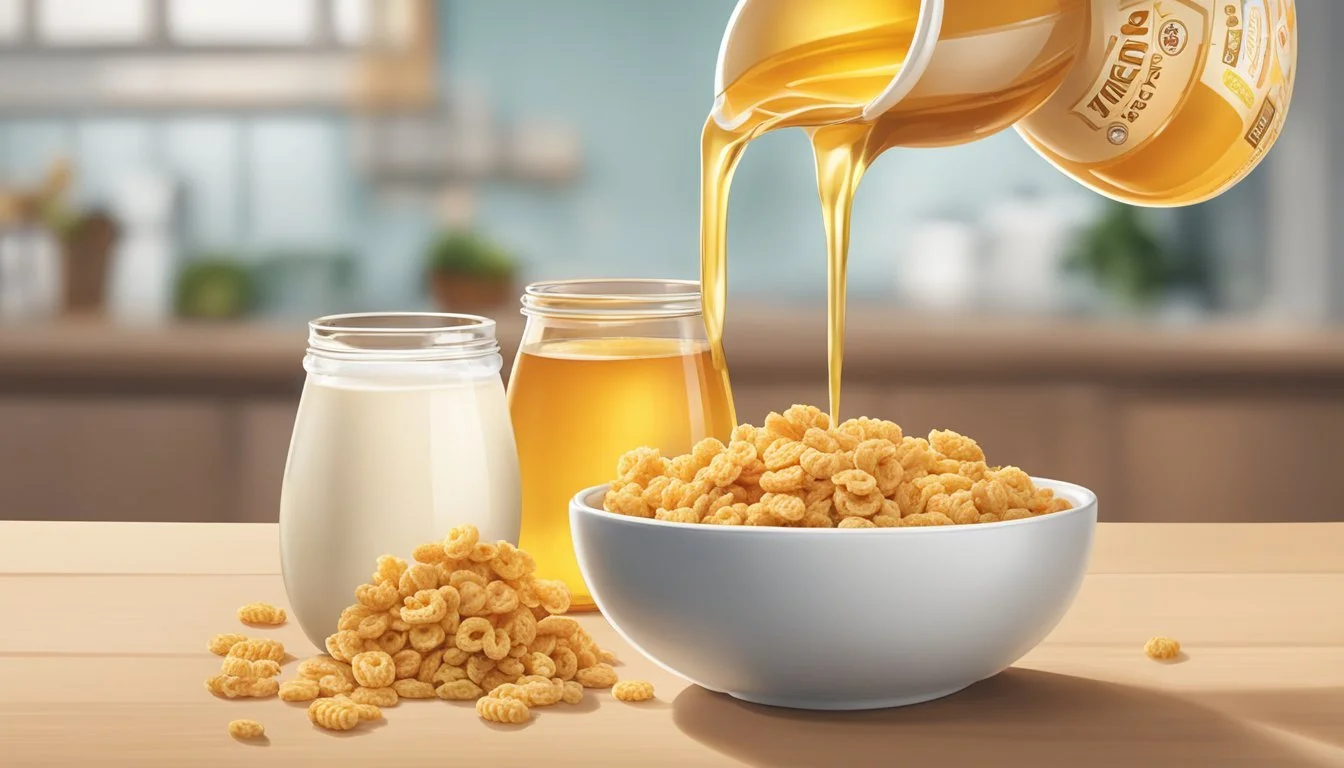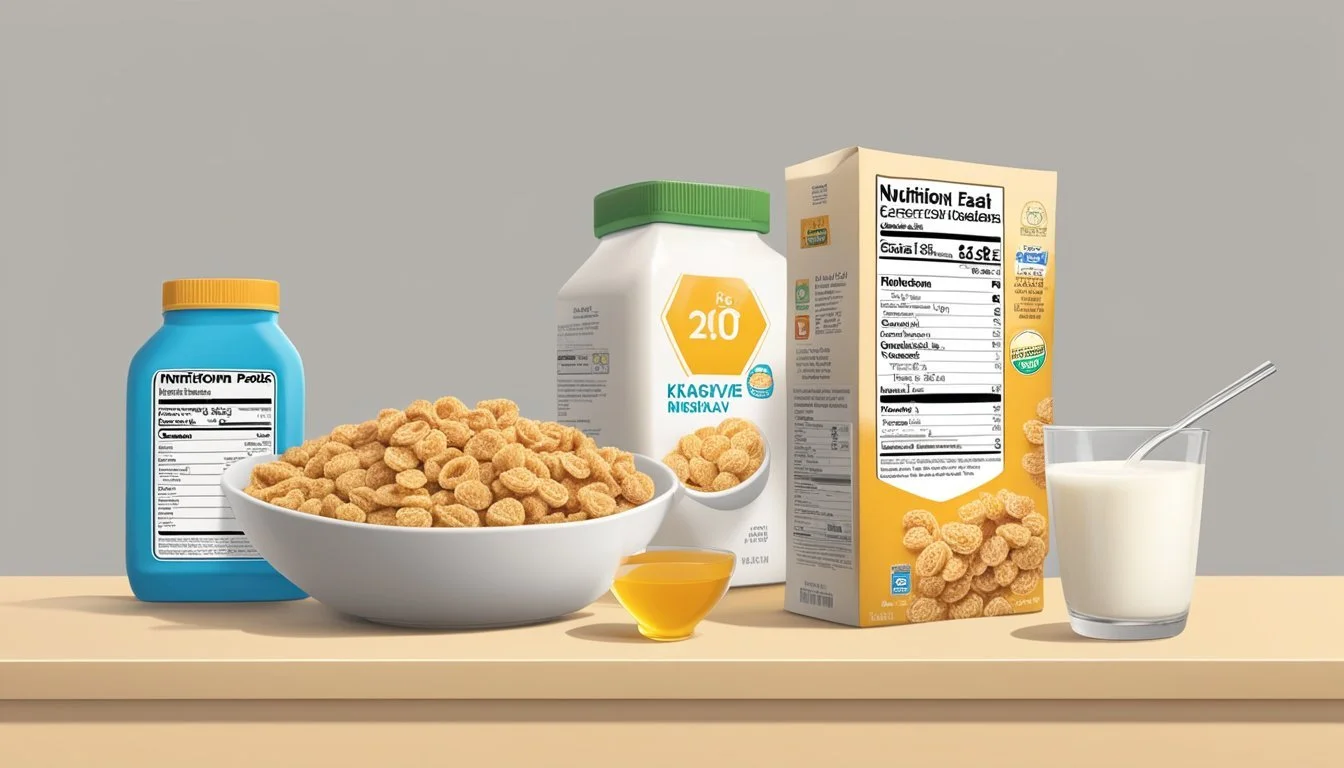Honey Ohs! vs Krave
Comparing Breakfast Cereals
This Article is Part of Our Breakfast Cereal Guide with Details on Honey Ohs! Nutrition and Krave Nutrition
When it comes to breakfast cereals, Honey Ohs! and Krave are two popular options that offer distinct flavors and nutritional profiles. Honey Ohs! has been around since 1980, recognized for its crunchy texture and sweet honey flavor. This cereal has evolved over the years, primarily available now in the Honey Graham variant, delivering a combination of sweetness and crunch in every bite.
Krave, on the other hand, is relatively newer but has quickly gained popularity for its indulgent chocolate-filled bites. Although Krave’s double chocolate and cookie dough versions are mouthwatering, they often come with higher sugar content, making them a less healthy choice compared to many other cereals. When comparing these two cereals, Honey Ohs! tends to provide a marginally better nutritional profile, with fewer sugars and a slightly better balance of carbs and protein.
Both cereals cater to different taste preferences and nutritional needs, making them unique in their right. Whether you’re drawn to the nostalgic crunch of Honey Ohs! or the chocolaty allure of Krave, understanding their differences can help you choose the right start to your day.
Overview of Honey Ohs! and Krave
Honey Ohs! and Krave are two popular breakfast cereals, each with its own unique ingredients, flavors, and histories. Both have undergone changes and developments to meet market demands and preferences.
Brand History
Honey Ohs! was originally introduced by Quaker Oats. It gained popularity for its honey and graham flavor, attracting a loyal customer base. In August 2014, the brand was acquired by Post Cereals. Post continued to produce Honey Ohs!, maintaining the product's quality and flavor, which is essential for long-time fans.
Krave, on the other hand, is a more recent entrant in the cereal market. Launched by Kellogg's, it quickly captured attention with its chocolate-filled center. Kellogg's aimed to target younger consumers and chocolate lovers, establishing Krave as a fun and indulgent breakfast option.
Product Evolution
Honey Ohs! has remained relatively consistent in its formula and taste since its introduction. The transition from Quaker Oats to Post Cereals did not significantly alter the product, allowing it to retain its original appeal. The cereal's honey and graham combination remains a key selling point, contributing to its staying power.
Krave has seen more innovation in its short lifespan. Kellogg's has expanded the line to include different flavors and limited editions, such as the "More Chocolate!" variant. These changes reflect consumer trends and the brand's strategy to keep the product exciting and versatile. Krave's focus on a chocolate-filled center emphasizes indulgence, differentiating it in the crowded cereal market.
Nutritional Comparison
When comparing Honey Ohs! and Krave cereals, it's essential to consider their caloric, protein, and sugar content, as well as their vitamins and minerals, to make an informed choice.
Caloric Content
Krave cereal contains approximately 120 calories per serving. In comparison, Honey Ohs! provides about 110 calories per serving.
Both cereals fall within a similar caloric range, making neither exceptionally high regarding calorie count.
It is important to consider additional aspects such as serving size, as this can influence daily calorie intake from cereal consumption.
Protein Content
Protein is crucial for body repair and muscle maintenance. Honey Ohs! offers about 2 grams of protein per serving.
Krave, on the other hand, contains around 3 grams of protein per serving.
While neither cereal is a significant protein source, Krave does provide slightly more, which might be more beneficial for those looking to increase their protein intake from breakfast.
Sugar Content
Sugar content is a critical factor in determining the healthiness of a cereal. Honey Ohs! has around 11 grams of sugar per serving.
Krave contains approximately 9 grams of sugar per serving.
Both cereals have a substantial sugar amount, but Krave has a marginally lower sugar content, which might make it a slightly better option for those monitoring their sugar intake.
Vitamins and Minerals
Both Honey Ohs! and Krave cereals are fortified with essential vitamins and minerals.
Honey Ohs! includes vitamins such as B6, niacin, and folic acid.
Krave also provides vital nutrients like vitamins D and B6, niacin, and calcium.
Additionally, both cereals contain iron and zinc. These nutrients play significant roles in maintaining health and supporting bodily functions, making both options beneficial in providing essential vitamins and minerals to one's diet.
Ingredients and Flavors
Comparing Honey Ohs! and Krave reveals interesting findings about their key ingredients and flavor profiles, as well as the additives used in each cereal.
Key Ingredients
Honey Ohs! boasts ingredients like corn flour, oat flour, and graham flour. This cereal also contains brown sugar, honey, molasses, and salt. These ingredients make a unique blend that provides a sweet and crunchy taste.
Krave, on the other hand, highlights whole grain and multigrain components. Key ingredients include whole wheat flour, rice flour, oat flour, and corn flour. The chocolate flavor is prominent with the inclusion of cocoa and real chocolate.
Both cereals use a variety of grains, but their emphasis differs with Honey Ohs! focusing on a honey and oat blend, while Krave prioritizes chocolate and multigrain components.
Flavor Profiles
Honey Ohs! delivers a sweet, honey-flavored cereal with a crunchy texture. The inclusion of graham flour and molasses gives it a distinct flavor compared to other standard cereals. The taste is balanced with a mix of sugary sweetness from the honey and a subtle hint of saltiness.
Krave offers a rich, chocolatey experience. The cereal is filled with chocolate and has a crunchy outer shell made from multigrain flour. Varieties like Krave double chocolate add an extra layer of chocolate filling, enhancing the overall taste. The combination of grains and chocolate provides a robust and indulgent flavor profile.
Additives
Additives in Honey Ohs! include corn syrup, palm oil, and artificial flavor. These ingredients help to preserve the cereal and enhance its taste. Additional minerals such as zinc oxide are also included for nutritional benefits.
Krave contains soy lecithin, canola oil, and natural flavoring among its additives. The cereal also includes baking soda and color additives like yellow 5 and yellow 6 to maintain its texture and appearance.
Both cereals employ a mix of oils, syrup, and flavor enhancers. However, Krave tends to use more colorings and stabilizers compared to Honey Ohs!. These differences in additives cater to the specific textures and tastes desired in each cereal.
Dietary Considerations
Choosing between Honey Ohs! and Krave for breakfast involves considering specific dietary needs such as allergen content and the overall healthiness of each option. This section explores these aspects in detail.
Gluten and Allergens
Honey Ohs! and Krave each have unique ingredient profiles that may affect those with food sensitivities. Honey Ohs! contain wheat and are not suitable for gluten-free diets. Krave also contains wheat, making it unsuitable for those with gluten intolerance or celiac disease.
Beyond gluten, neither cereal is specifically marketed as free from common allergens like soy or peanuts, so individuals with these allergies should read ingredient labels carefully. It's important to note that while these cereals offer tasty breakfast options, individuals with allergies must verify ingredient safety.
Healthy Breakfast Options
When it comes to choosing a healthy breakfast, both Honey Ohs! and Krave present distinct nutritional profiles. Honey Ohs! contain 170 calories, 3g of total fat, and 11 grams of sugars per serving. Comparatively, Krave's nutritional composition leans heavily on sugars and whole grains, appealing to those seeking a treat-like breakfast.
In terms of dietary fiber, Honey Ohs! offers 1 gram per serving. While low, it's comparable to many sugary cereals. For a more balanced breakfast, incorporating items like banana slices or a side of peanut butter toast could boost nutritional value and offer a more filling and satisfying meal. This strategy provides essential nutrients while enjoying the sweet taste of these cereals.
Consumer Experience
Consumers often consider aspects like texture, crunch, and brand presence when choosing between Honey Ohs! and Krave. These attributes significantly shape how the products interact with taste buds and consumption habits.
Texture and Crunch
Honey Ohs! offer a dense, crunchy experience that holds up well in milk. Its robust texture provides a long-lasting crunch, pleasing those who enjoy a hearty bite. In contrast, Krave delivers a softer crunch owing to its chocolate-filled centers.
The creamy interior of Krave can dissolve more quickly in milk, creating an engaging contrast between the outer shell and the softened filling. This difference in texture can influence preference based on how long the consumer likes their cereal to maintain its crunch.
Serving Suggestions
Honey Ohs!:
Snack Mix: Combines well with nuts and dried fruits.
Traditional Cereal: Stays crunchy in milk.
Topping: Works as a crunchy addition to yogurt.
Krave:
Chocolate Treat: Enjoyed dry as a sweet snack.
Cereal Bowl: Interesting texture when paired with milk.
Dessert Ingredient: Can be used in ice cream or baked goods.
Honey Ohs! naturally lend themselves to snacking due to their durable crunch, whereas Krave’s chocolate aspect makes it versatile for both sweet snacks and dessert enhancements.
Brand Presence
Post manufactures Honey Ohs!, though it was originally introduced by Quaker. This switch may cause variation in availability, but the brand remains recognizable to consumers. Post's commitment to traditional cereals solidifies Honey Ohs! place on store shelves.
Krave, with its unique chocolate filling, stands out in the breakfast aisle. The brand's playful marketing and focus on indulgent flavors attract those looking for a more luxurious breakfast experience.
The strong brand presence of both cereals ensures accessibility in various regions and stores, appealing to different consumer bases seeking either a robust crunch or a chocolatey bite.
Market Performance and Availability
The market performance and availability of Honey Ohs! and Krave cereals differ significantly. These disparities are shaped by sales trends and global distribution strategies.
Sales and Popularity Trends
Honey Ohs!, originally introduced by Quaker Oats and now produced by Post Cereals, has established a dedicated consumer base. This cereal appeals to those seeking a nostalgic breakfast option. Sales surged particularly post-rebranding in 2014, indicating a positive market reception. In contrast, Krave cereal, known for its chocolate-filled bites, has targeted a younger audience. While offering indulgent flavors like chocolate and double chocolate, Krave's initial success has experienced fluctuations based on market trends and competition. Their innovative marketing strategies have played a crucial role in maintaining a notable presence in the cereal market.
Global Distribution
Honey Ohs! is widely available across North America but remains less prominent in international markets. Its distribution focuses primarily on major grocery chains and select online retailers. Krave, however, has a broader global reach, benefiting from Kellogg’s extensive distribution network. Available in regions including Europe and Asia, Krave adapts its product offerings to meet local tastes. Despite the geographical differences in their availability, both brands maintain a strong retail presence, supported by strategic partnerships with leading supermarket chains and e-commerce platforms. This ensures consistent accessibility for their diverse consumer bases.
Environmental and Ethical Considerations
When examining the environmental and ethical considerations of Honey Ohs! and Krave cereals, it is important to focus on their sustainability initiatives and packaging waste reduction efforts. These factors significantly influence their environmental impact and demonstrate their commitment to corporate responsibility.
Sustainability Initiatives
Both Honey Ohs! and Krave have implemented various sustainability measures to minimize their environmental footprint. Honey Ohs!, for instance, sources ingredients from farms that employ sustainable agriculture practices. This includes minimizing pesticide use and promoting soil health.
Krave prioritizes the use of ethically sourced cocoa for its chocolate-flavored cereal, ensuring that farmers receive fair compensation and that environmental practices are enforced. Both brands also focus on reducing their carbon footprint by optimizing transportation methods and sourcing ingredients locally when possible.
Packaging and Waste Reduction
Packaging waste is a critical area for improvement for both Honey Ohs! and Krave. Honey Ohs! has transitioned to using recycled and recyclable materials for its packaging. Their boxes are designed to minimize waste, using just enough material to protect the product without excessive use.
Krave has made strides in reducing plastic use by adapting more eco-friendly packaging solutions. They also encourage consumers to recycle through clear labeling and provide information on their website about how to properly dispose of packaging materials.
By focusing on packaging innovations and waste reduction, both brands strive to lessen their environmental impact while promoting responsible consumption habits among their customers.









